Cheers Craft Beer: Market Analysis and Expansion Strategy MNG 92210
VerifiedAdded on 2023/06/15
|19
|5514
|440
Report
AI Summary
This report examines the potential for craft beer company 'Cheers' to expand into overseas markets, specifically India and Brazil, to sustain its growth. It identifies opportunities and challenges in both markets, ultimately recommending Brazil as the preferred destination due to its more favorable government policies and consumer acceptance of craft beer. The report suggests a franchise model for entering the Brazilian market, emphasizing the importance of strong intellectual property laws and effective management and marketing strategies. Key considerations include financial, country-specific, and cultural risks, with a focus on logistics and infrastructure challenges in Brazil. The report also highlights the need for careful employee selection to manage foreign operations effectively, ensuring 'Cheers' can capitalize on the growing craft beer market in Brazil.
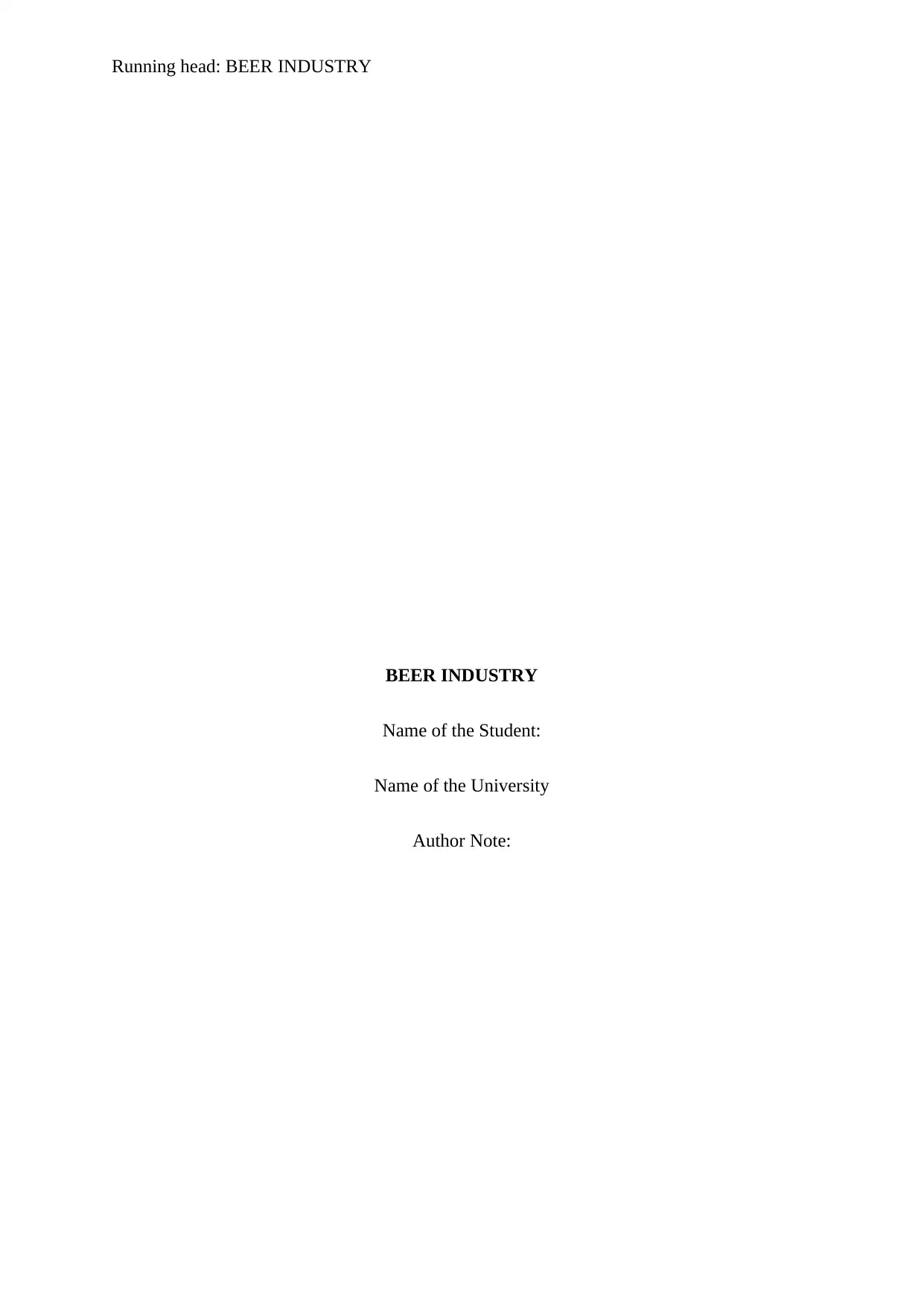
Running head: BEER INDUSTRY
BEER INDUSTRY
Name of the Student:
Name of the University
Author Note:
BEER INDUSTRY
Name of the Student:
Name of the University
Author Note:
Paraphrase This Document
Need a fresh take? Get an instant paraphrase of this document with our AI Paraphraser
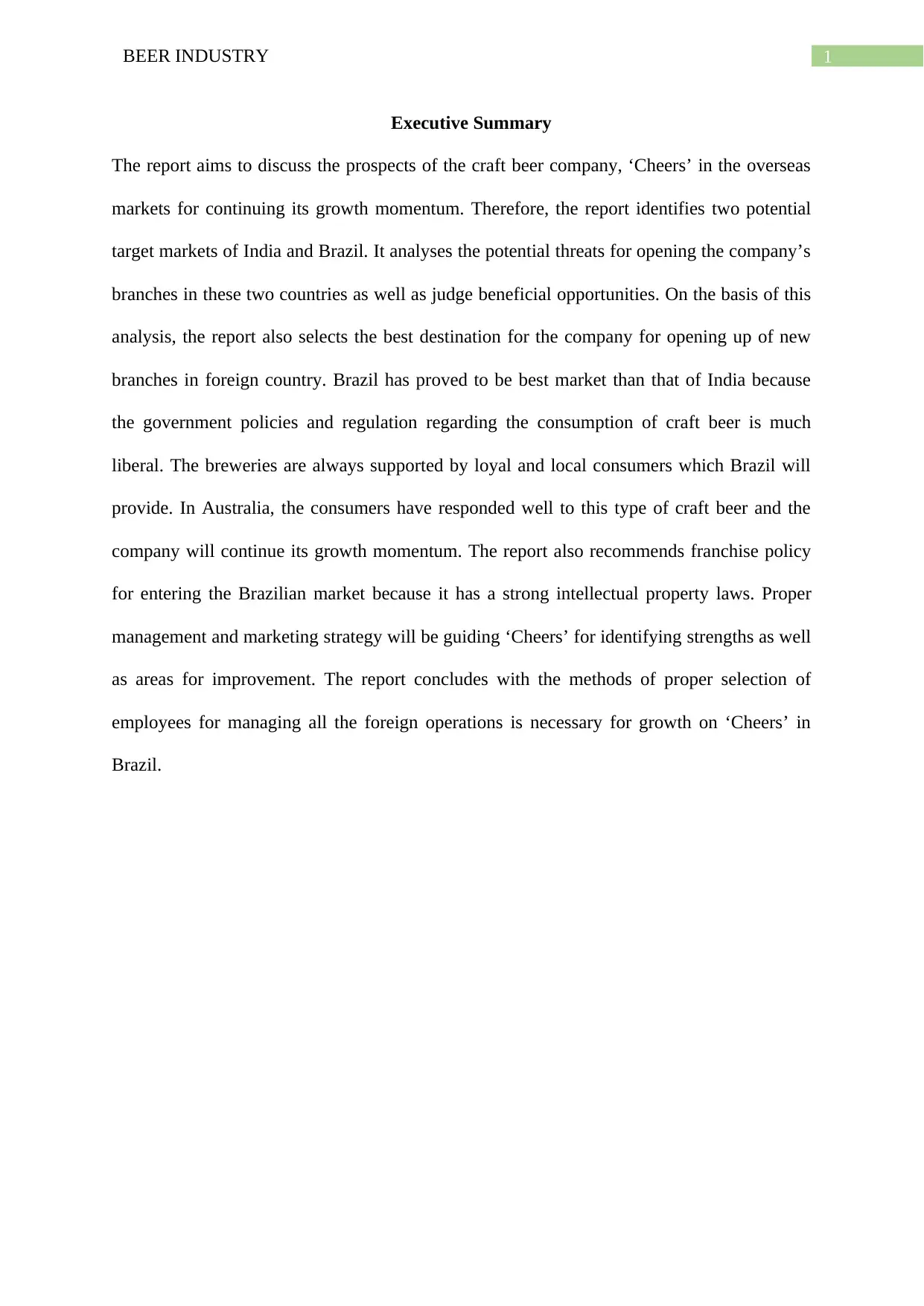
1BEER INDUSTRY
Executive Summary
The report aims to discuss the prospects of the craft beer company, ‘Cheers’ in the overseas
markets for continuing its growth momentum. Therefore, the report identifies two potential
target markets of India and Brazil. It analyses the potential threats for opening the company’s
branches in these two countries as well as judge beneficial opportunities. On the basis of this
analysis, the report also selects the best destination for the company for opening up of new
branches in foreign country. Brazil has proved to be best market than that of India because
the government policies and regulation regarding the consumption of craft beer is much
liberal. The breweries are always supported by loyal and local consumers which Brazil will
provide. In Australia, the consumers have responded well to this type of craft beer and the
company will continue its growth momentum. The report also recommends franchise policy
for entering the Brazilian market because it has a strong intellectual property laws. Proper
management and marketing strategy will be guiding ‘Cheers’ for identifying strengths as well
as areas for improvement. The report concludes with the methods of proper selection of
employees for managing all the foreign operations is necessary for growth on ‘Cheers’ in
Brazil.
Executive Summary
The report aims to discuss the prospects of the craft beer company, ‘Cheers’ in the overseas
markets for continuing its growth momentum. Therefore, the report identifies two potential
target markets of India and Brazil. It analyses the potential threats for opening the company’s
branches in these two countries as well as judge beneficial opportunities. On the basis of this
analysis, the report also selects the best destination for the company for opening up of new
branches in foreign country. Brazil has proved to be best market than that of India because
the government policies and regulation regarding the consumption of craft beer is much
liberal. The breweries are always supported by loyal and local consumers which Brazil will
provide. In Australia, the consumers have responded well to this type of craft beer and the
company will continue its growth momentum. The report also recommends franchise policy
for entering the Brazilian market because it has a strong intellectual property laws. Proper
management and marketing strategy will be guiding ‘Cheers’ for identifying strengths as well
as areas for improvement. The report concludes with the methods of proper selection of
employees for managing all the foreign operations is necessary for growth on ‘Cheers’ in
Brazil.
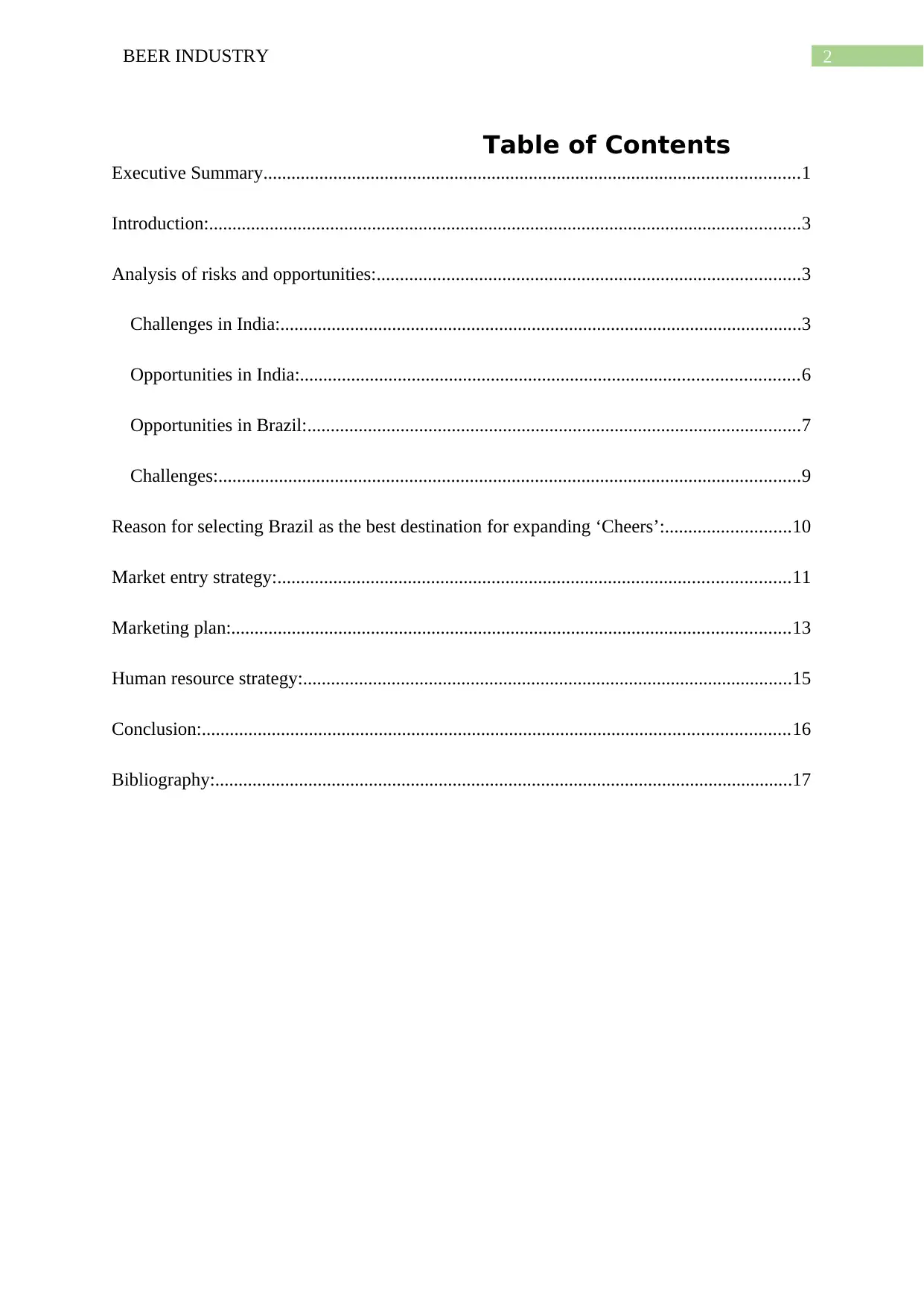
2BEER INDUSTRY
Table of Contents
Executive Summary...................................................................................................................1
Introduction:...............................................................................................................................3
Analysis of risks and opportunities:...........................................................................................3
Challenges in India:................................................................................................................3
Opportunities in India:...........................................................................................................6
Opportunities in Brazil:..........................................................................................................7
Challenges:.............................................................................................................................9
Reason for selecting Brazil as the best destination for expanding ‘Cheers’:...........................10
Market entry strategy:..............................................................................................................11
Marketing plan:........................................................................................................................13
Human resource strategy:.........................................................................................................15
Conclusion:..............................................................................................................................16
Bibliography:............................................................................................................................17
Table of Contents
Executive Summary...................................................................................................................1
Introduction:...............................................................................................................................3
Analysis of risks and opportunities:...........................................................................................3
Challenges in India:................................................................................................................3
Opportunities in India:...........................................................................................................6
Opportunities in Brazil:..........................................................................................................7
Challenges:.............................................................................................................................9
Reason for selecting Brazil as the best destination for expanding ‘Cheers’:...........................10
Market entry strategy:..............................................................................................................11
Marketing plan:........................................................................................................................13
Human resource strategy:.........................................................................................................15
Conclusion:..............................................................................................................................16
Bibliography:............................................................................................................................17
⊘ This is a preview!⊘
Do you want full access?
Subscribe today to unlock all pages.

Trusted by 1+ million students worldwide
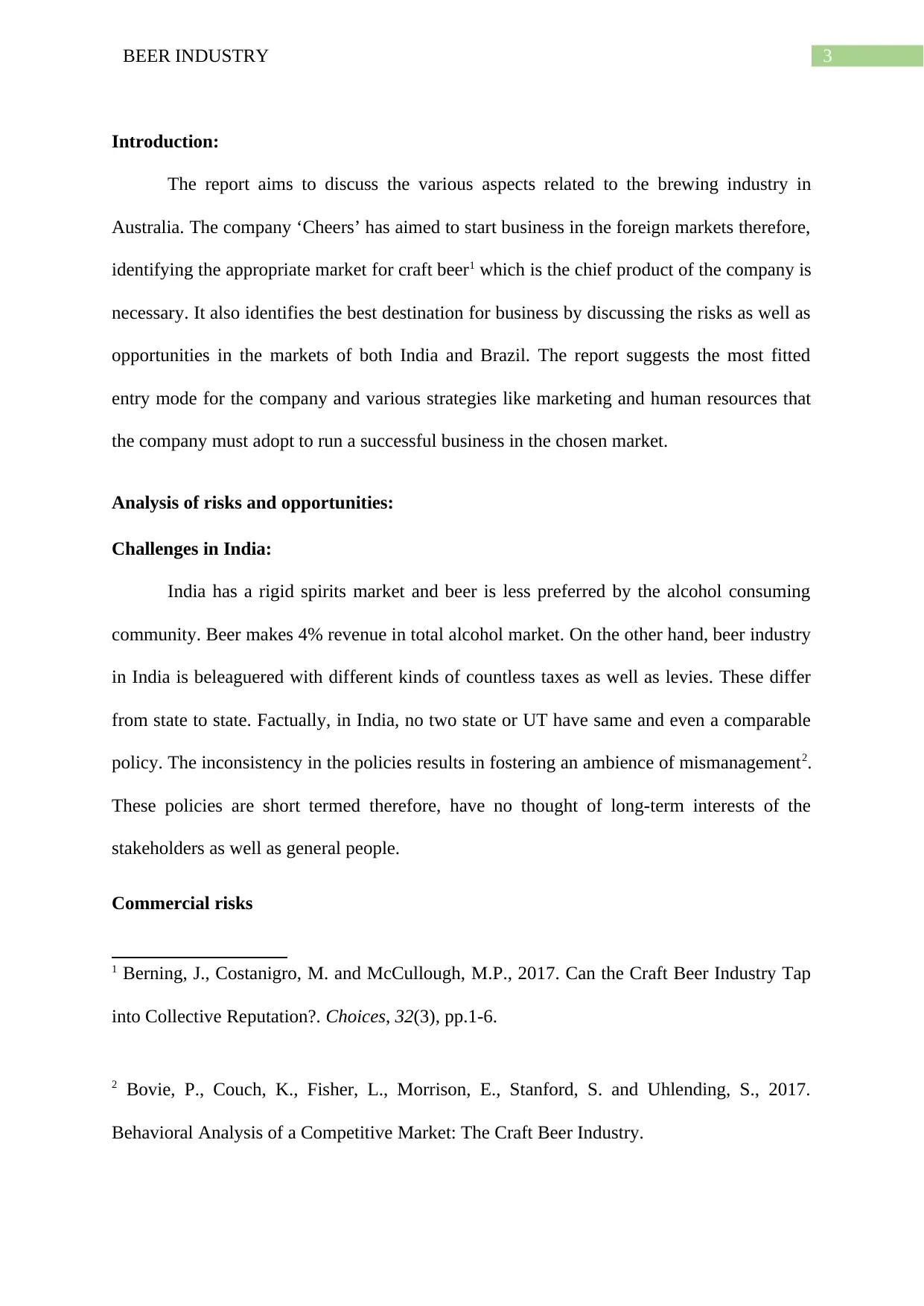
3BEER INDUSTRY
Introduction:
The report aims to discuss the various aspects related to the brewing industry in
Australia. The company ‘Cheers’ has aimed to start business in the foreign markets therefore,
identifying the appropriate market for craft beer1 which is the chief product of the company is
necessary. It also identifies the best destination for business by discussing the risks as well as
opportunities in the markets of both India and Brazil. The report suggests the most fitted
entry mode for the company and various strategies like marketing and human resources that
the company must adopt to run a successful business in the chosen market.
Analysis of risks and opportunities:
Challenges in India:
India has a rigid spirits market and beer is less preferred by the alcohol consuming
community. Beer makes 4% revenue in total alcohol market. On the other hand, beer industry
in India is beleaguered with different kinds of countless taxes as well as levies. These differ
from state to state. Factually, in India, no two state or UT have same and even a comparable
policy. The inconsistency in the policies results in fostering an ambience of mismanagement2.
These policies are short termed therefore, have no thought of long-term interests of the
stakeholders as well as general people.
Commercial risks
1 Berning, J., Costanigro, M. and McCullough, M.P., 2017. Can the Craft Beer Industry Tap
into Collective Reputation?. Choices, 32(3), pp.1-6.
2 Bovie, P., Couch, K., Fisher, L., Morrison, E., Stanford, S. and Uhlending, S., 2017.
Behavioral Analysis of a Competitive Market: The Craft Beer Industry.
Introduction:
The report aims to discuss the various aspects related to the brewing industry in
Australia. The company ‘Cheers’ has aimed to start business in the foreign markets therefore,
identifying the appropriate market for craft beer1 which is the chief product of the company is
necessary. It also identifies the best destination for business by discussing the risks as well as
opportunities in the markets of both India and Brazil. The report suggests the most fitted
entry mode for the company and various strategies like marketing and human resources that
the company must adopt to run a successful business in the chosen market.
Analysis of risks and opportunities:
Challenges in India:
India has a rigid spirits market and beer is less preferred by the alcohol consuming
community. Beer makes 4% revenue in total alcohol market. On the other hand, beer industry
in India is beleaguered with different kinds of countless taxes as well as levies. These differ
from state to state. Factually, in India, no two state or UT have same and even a comparable
policy. The inconsistency in the policies results in fostering an ambience of mismanagement2.
These policies are short termed therefore, have no thought of long-term interests of the
stakeholders as well as general people.
Commercial risks
1 Berning, J., Costanigro, M. and McCullough, M.P., 2017. Can the Craft Beer Industry Tap
into Collective Reputation?. Choices, 32(3), pp.1-6.
2 Bovie, P., Couch, K., Fisher, L., Morrison, E., Stanford, S. and Uhlending, S., 2017.
Behavioral Analysis of a Competitive Market: The Craft Beer Industry.
Paraphrase This Document
Need a fresh take? Get an instant paraphrase of this document with our AI Paraphraser
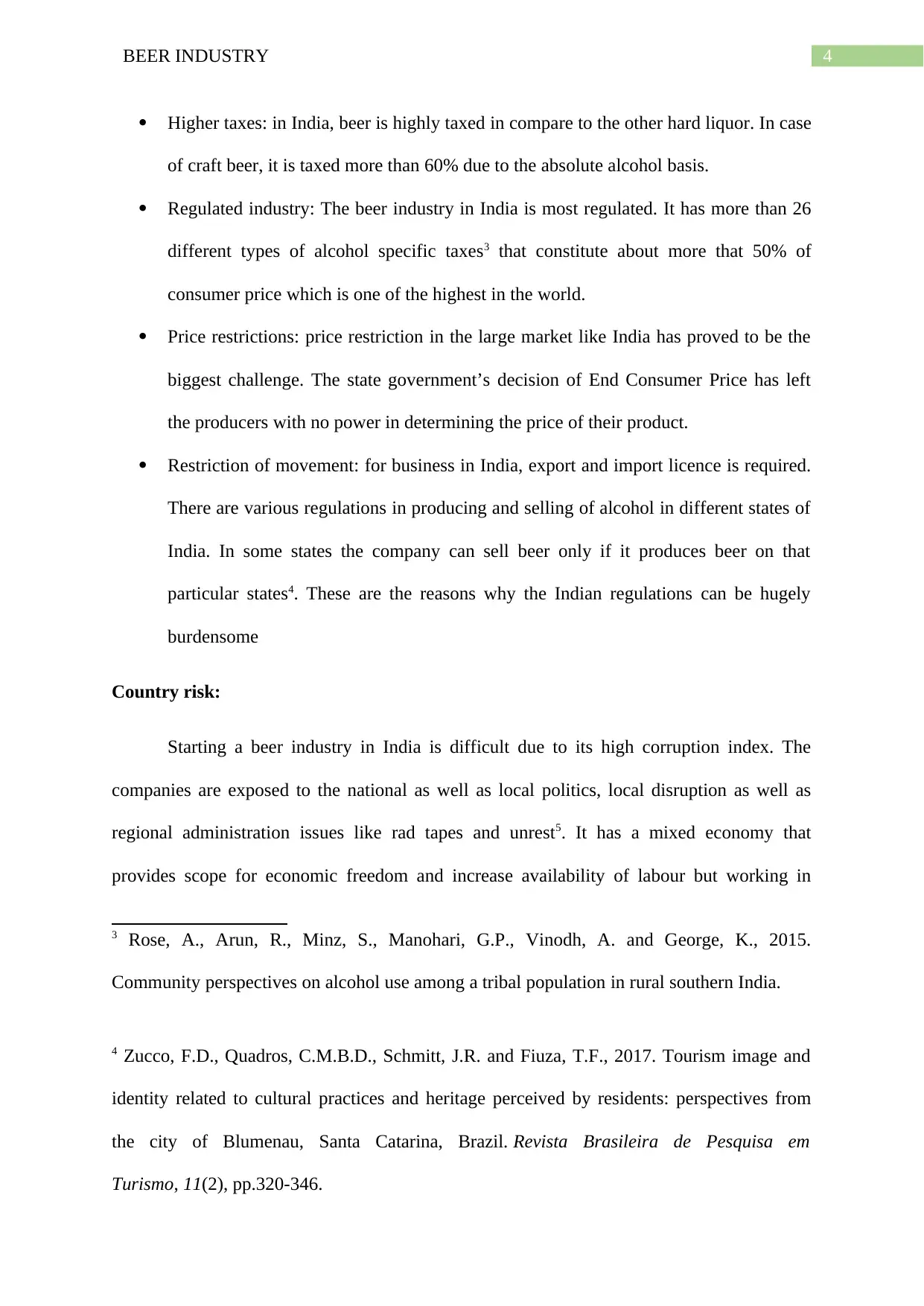
4BEER INDUSTRY
Higher taxes: in India, beer is highly taxed in compare to the other hard liquor. In case
of craft beer, it is taxed more than 60% due to the absolute alcohol basis.
Regulated industry: The beer industry in India is most regulated. It has more than 26
different types of alcohol specific taxes3 that constitute about more that 50% of
consumer price which is one of the highest in the world.
Price restrictions: price restriction in the large market like India has proved to be the
biggest challenge. The state government’s decision of End Consumer Price has left
the producers with no power in determining the price of their product.
Restriction of movement: for business in India, export and import licence is required.
There are various regulations in producing and selling of alcohol in different states of
India. In some states the company can sell beer only if it produces beer on that
particular states4. These are the reasons why the Indian regulations can be hugely
burdensome
Country risk:
Starting a beer industry in India is difficult due to its high corruption index. The
companies are exposed to the national as well as local politics, local disruption as well as
regional administration issues like rad tapes and unrest5. It has a mixed economy that
provides scope for economic freedom and increase availability of labour but working in
3 Rose, A., Arun, R., Minz, S., Manohari, G.P., Vinodh, A. and George, K., 2015.
Community perspectives on alcohol use among a tribal population in rural southern India.
4 Zucco, F.D., Quadros, C.M.B.D., Schmitt, J.R. and Fiuza, T.F., 2017. Tourism image and
identity related to cultural practices and heritage perceived by residents: perspectives from
the city of Blumenau, Santa Catarina, Brazil. Revista Brasileira de Pesquisa em
Turismo, 11(2), pp.320-346.
Higher taxes: in India, beer is highly taxed in compare to the other hard liquor. In case
of craft beer, it is taxed more than 60% due to the absolute alcohol basis.
Regulated industry: The beer industry in India is most regulated. It has more than 26
different types of alcohol specific taxes3 that constitute about more that 50% of
consumer price which is one of the highest in the world.
Price restrictions: price restriction in the large market like India has proved to be the
biggest challenge. The state government’s decision of End Consumer Price has left
the producers with no power in determining the price of their product.
Restriction of movement: for business in India, export and import licence is required.
There are various regulations in producing and selling of alcohol in different states of
India. In some states the company can sell beer only if it produces beer on that
particular states4. These are the reasons why the Indian regulations can be hugely
burdensome
Country risk:
Starting a beer industry in India is difficult due to its high corruption index. The
companies are exposed to the national as well as local politics, local disruption as well as
regional administration issues like rad tapes and unrest5. It has a mixed economy that
provides scope for economic freedom and increase availability of labour but working in
3 Rose, A., Arun, R., Minz, S., Manohari, G.P., Vinodh, A. and George, K., 2015.
Community perspectives on alcohol use among a tribal population in rural southern India.
4 Zucco, F.D., Quadros, C.M.B.D., Schmitt, J.R. and Fiuza, T.F., 2017. Tourism image and
identity related to cultural practices and heritage perceived by residents: perspectives from
the city of Blumenau, Santa Catarina, Brazil. Revista Brasileira de Pesquisa em
Turismo, 11(2), pp.320-346.
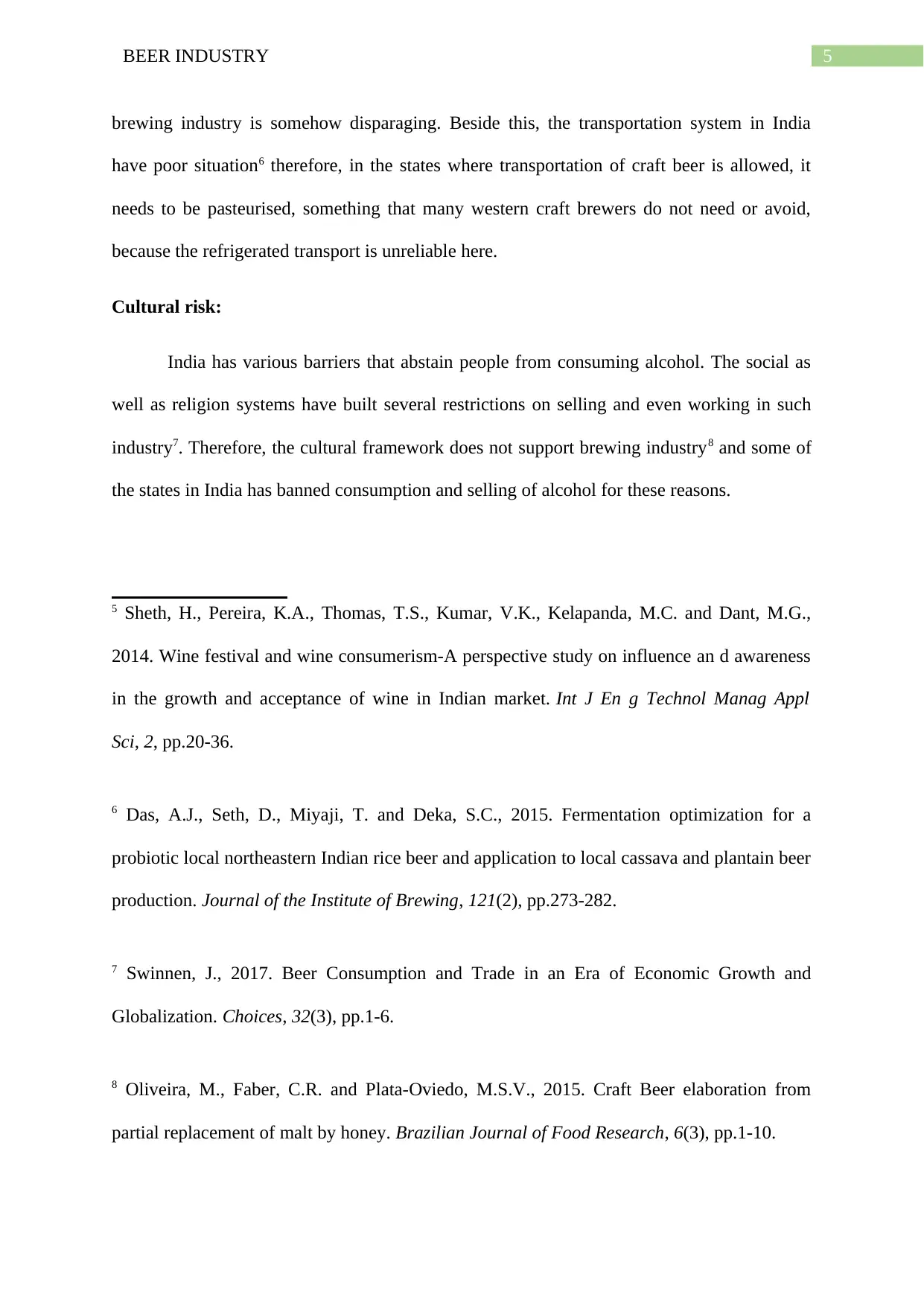
5BEER INDUSTRY
brewing industry is somehow disparaging. Beside this, the transportation system in India
have poor situation6 therefore, in the states where transportation of craft beer is allowed, it
needs to be pasteurised, something that many western craft brewers do not need or avoid,
because the refrigerated transport is unreliable here.
Cultural risk:
India has various barriers that abstain people from consuming alcohol. The social as
well as religion systems have built several restrictions on selling and even working in such
industry7. Therefore, the cultural framework does not support brewing industry8 and some of
the states in India has banned consumption and selling of alcohol for these reasons.
5 Sheth, H., Pereira, K.A., Thomas, T.S., Kumar, V.K., Kelapanda, M.C. and Dant, M.G.,
2014. Wine festival and wine consumerism-A perspective study on influence an d awareness
in the growth and acceptance of wine in Indian market. Int J En g Technol Manag Appl
Sci, 2, pp.20-36.
6 Das, A.J., Seth, D., Miyaji, T. and Deka, S.C., 2015. Fermentation optimization for a
probiotic local northeastern Indian rice beer and application to local cassava and plantain beer
production. Journal of the Institute of Brewing, 121(2), pp.273-282.
7 Swinnen, J., 2017. Beer Consumption and Trade in an Era of Economic Growth and
Globalization. Choices, 32(3), pp.1-6.
8 Oliveira, M., Faber, C.R. and Plata-Oviedo, M.S.V., 2015. Craft Beer elaboration from
partial replacement of malt by honey. Brazilian Journal of Food Research, 6(3), pp.1-10.
brewing industry is somehow disparaging. Beside this, the transportation system in India
have poor situation6 therefore, in the states where transportation of craft beer is allowed, it
needs to be pasteurised, something that many western craft brewers do not need or avoid,
because the refrigerated transport is unreliable here.
Cultural risk:
India has various barriers that abstain people from consuming alcohol. The social as
well as religion systems have built several restrictions on selling and even working in such
industry7. Therefore, the cultural framework does not support brewing industry8 and some of
the states in India has banned consumption and selling of alcohol for these reasons.
5 Sheth, H., Pereira, K.A., Thomas, T.S., Kumar, V.K., Kelapanda, M.C. and Dant, M.G.,
2014. Wine festival and wine consumerism-A perspective study on influence an d awareness
in the growth and acceptance of wine in Indian market. Int J En g Technol Manag Appl
Sci, 2, pp.20-36.
6 Das, A.J., Seth, D., Miyaji, T. and Deka, S.C., 2015. Fermentation optimization for a
probiotic local northeastern Indian rice beer and application to local cassava and plantain beer
production. Journal of the Institute of Brewing, 121(2), pp.273-282.
7 Swinnen, J., 2017. Beer Consumption and Trade in an Era of Economic Growth and
Globalization. Choices, 32(3), pp.1-6.
8 Oliveira, M., Faber, C.R. and Plata-Oviedo, M.S.V., 2015. Craft Beer elaboration from
partial replacement of malt by honey. Brazilian Journal of Food Research, 6(3), pp.1-10.
⊘ This is a preview!⊘
Do you want full access?
Subscribe today to unlock all pages.

Trusted by 1+ million students worldwide
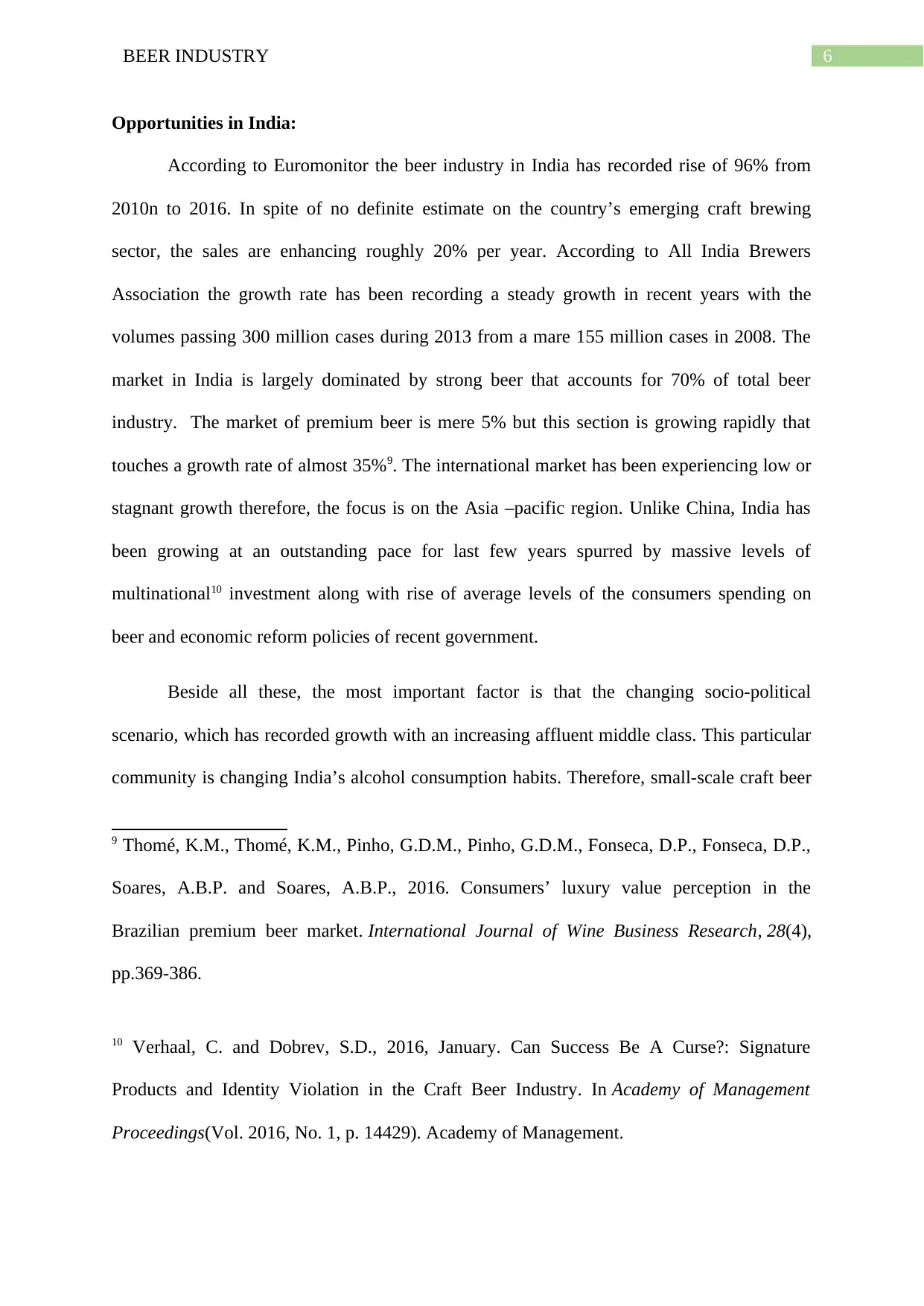
6BEER INDUSTRY
Opportunities in India:
According to Euromonitor the beer industry in India has recorded rise of 96% from
2010n to 2016. In spite of no definite estimate on the country’s emerging craft brewing
sector, the sales are enhancing roughly 20% per year. According to All India Brewers
Association the growth rate has been recording a steady growth in recent years with the
volumes passing 300 million cases during 2013 from a mare 155 million cases in 2008. The
market in India is largely dominated by strong beer that accounts for 70% of total beer
industry. The market of premium beer is mere 5% but this section is growing rapidly that
touches a growth rate of almost 35%9. The international market has been experiencing low or
stagnant growth therefore, the focus is on the Asia –pacific region. Unlike China, India has
been growing at an outstanding pace for last few years spurred by massive levels of
multinational10 investment along with rise of average levels of the consumers spending on
beer and economic reform policies of recent government.
Beside all these, the most important factor is that the changing socio-political
scenario, which has recorded growth with an increasing affluent middle class. This particular
community is changing India’s alcohol consumption habits. Therefore, small-scale craft beer
9 Thomé, K.M., Thomé, K.M., Pinho, G.D.M., Pinho, G.D.M., Fonseca, D.P., Fonseca, D.P.,
Soares, A.B.P. and Soares, A.B.P., 2016. Consumers’ luxury value perception in the
Brazilian premium beer market. International Journal of Wine Business Research, 28(4),
pp.369-386.
10 Verhaal, C. and Dobrev, S.D., 2016, January. Can Success Be A Curse?: Signature
Products and Identity Violation in the Craft Beer Industry. In Academy of Management
Proceedings(Vol. 2016, No. 1, p. 14429). Academy of Management.
Opportunities in India:
According to Euromonitor the beer industry in India has recorded rise of 96% from
2010n to 2016. In spite of no definite estimate on the country’s emerging craft brewing
sector, the sales are enhancing roughly 20% per year. According to All India Brewers
Association the growth rate has been recording a steady growth in recent years with the
volumes passing 300 million cases during 2013 from a mare 155 million cases in 2008. The
market in India is largely dominated by strong beer that accounts for 70% of total beer
industry. The market of premium beer is mere 5% but this section is growing rapidly that
touches a growth rate of almost 35%9. The international market has been experiencing low or
stagnant growth therefore, the focus is on the Asia –pacific region. Unlike China, India has
been growing at an outstanding pace for last few years spurred by massive levels of
multinational10 investment along with rise of average levels of the consumers spending on
beer and economic reform policies of recent government.
Beside all these, the most important factor is that the changing socio-political
scenario, which has recorded growth with an increasing affluent middle class. This particular
community is changing India’s alcohol consumption habits. Therefore, small-scale craft beer
9 Thomé, K.M., Thomé, K.M., Pinho, G.D.M., Pinho, G.D.M., Fonseca, D.P., Fonseca, D.P.,
Soares, A.B.P. and Soares, A.B.P., 2016. Consumers’ luxury value perception in the
Brazilian premium beer market. International Journal of Wine Business Research, 28(4),
pp.369-386.
10 Verhaal, C. and Dobrev, S.D., 2016, January. Can Success Be A Curse?: Signature
Products and Identity Violation in the Craft Beer Industry. In Academy of Management
Proceedings(Vol. 2016, No. 1, p. 14429). Academy of Management.
Paraphrase This Document
Need a fresh take? Get an instant paraphrase of this document with our AI Paraphraser
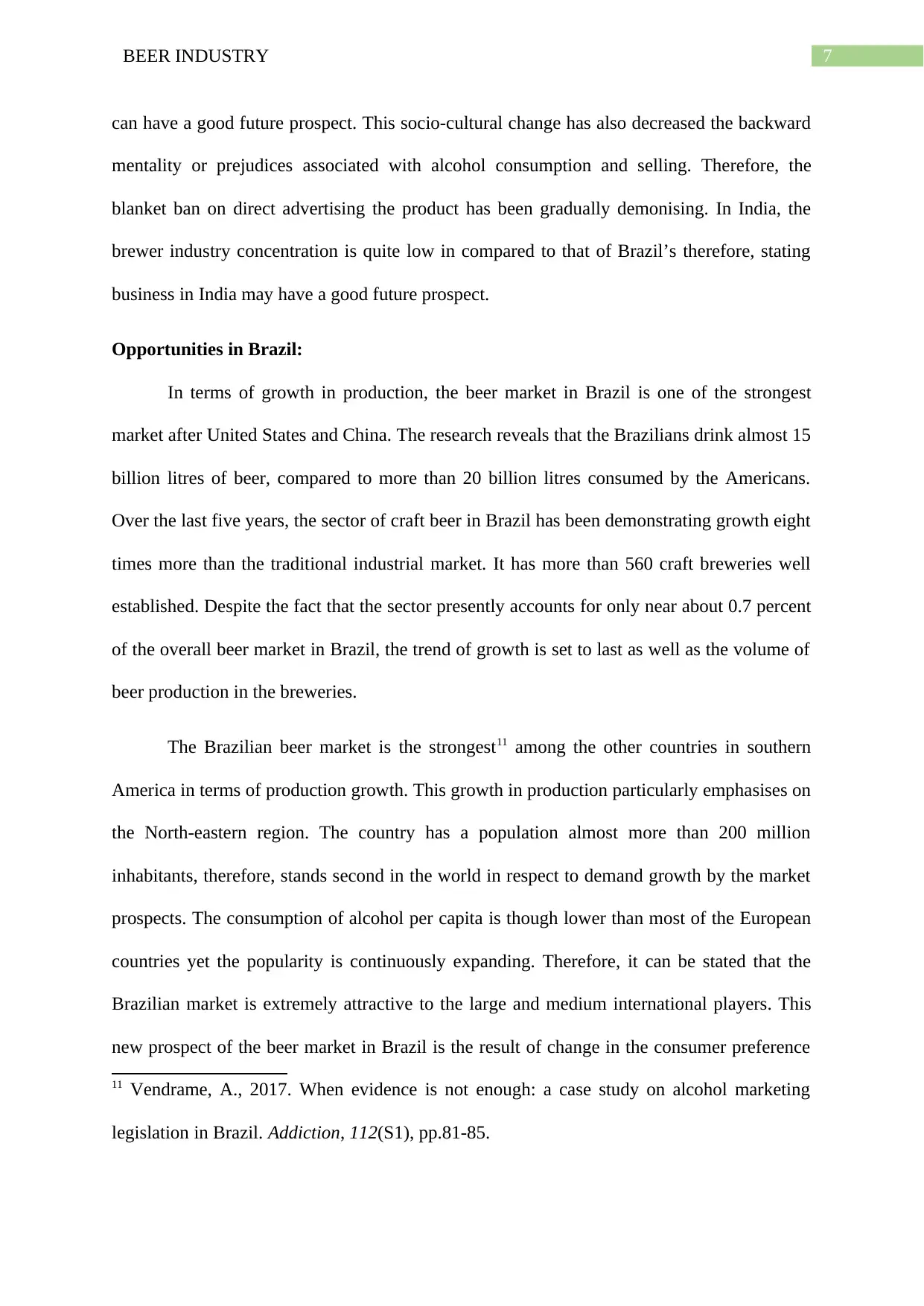
7BEER INDUSTRY
can have a good future prospect. This socio-cultural change has also decreased the backward
mentality or prejudices associated with alcohol consumption and selling. Therefore, the
blanket ban on direct advertising the product has been gradually demonising. In India, the
brewer industry concentration is quite low in compared to that of Brazil’s therefore, stating
business in India may have a good future prospect.
Opportunities in Brazil:
In terms of growth in production, the beer market in Brazil is one of the strongest
market after United States and China. The research reveals that the Brazilians drink almost 15
billion litres of beer, compared to more than 20 billion litres consumed by the Americans.
Over the last five years, the sector of craft beer in Brazil has been demonstrating growth eight
times more than the traditional industrial market. It has more than 560 craft breweries well
established. Despite the fact that the sector presently accounts for only near about 0.7 percent
of the overall beer market in Brazil, the trend of growth is set to last as well as the volume of
beer production in the breweries.
The Brazilian beer market is the strongest11 among the other countries in southern
America in terms of production growth. This growth in production particularly emphasises on
the North-eastern region. The country has a population almost more than 200 million
inhabitants, therefore, stands second in the world in respect to demand growth by the market
prospects. The consumption of alcohol per capita is though lower than most of the European
countries yet the popularity is continuously expanding. Therefore, it can be stated that the
Brazilian market is extremely attractive to the large and medium international players. This
new prospect of the beer market in Brazil is the result of change in the consumer preference
11 Vendrame, A., 2017. When evidence is not enough: a case study on alcohol marketing
legislation in Brazil. Addiction, 112(S1), pp.81-85.
can have a good future prospect. This socio-cultural change has also decreased the backward
mentality or prejudices associated with alcohol consumption and selling. Therefore, the
blanket ban on direct advertising the product has been gradually demonising. In India, the
brewer industry concentration is quite low in compared to that of Brazil’s therefore, stating
business in India may have a good future prospect.
Opportunities in Brazil:
In terms of growth in production, the beer market in Brazil is one of the strongest
market after United States and China. The research reveals that the Brazilians drink almost 15
billion litres of beer, compared to more than 20 billion litres consumed by the Americans.
Over the last five years, the sector of craft beer in Brazil has been demonstrating growth eight
times more than the traditional industrial market. It has more than 560 craft breweries well
established. Despite the fact that the sector presently accounts for only near about 0.7 percent
of the overall beer market in Brazil, the trend of growth is set to last as well as the volume of
beer production in the breweries.
The Brazilian beer market is the strongest11 among the other countries in southern
America in terms of production growth. This growth in production particularly emphasises on
the North-eastern region. The country has a population almost more than 200 million
inhabitants, therefore, stands second in the world in respect to demand growth by the market
prospects. The consumption of alcohol per capita is though lower than most of the European
countries yet the popularity is continuously expanding. Therefore, it can be stated that the
Brazilian market is extremely attractive to the large and medium international players. This
new prospect of the beer market in Brazil is the result of change in the consumer preference
11 Vendrame, A., 2017. When evidence is not enough: a case study on alcohol marketing
legislation in Brazil. Addiction, 112(S1), pp.81-85.
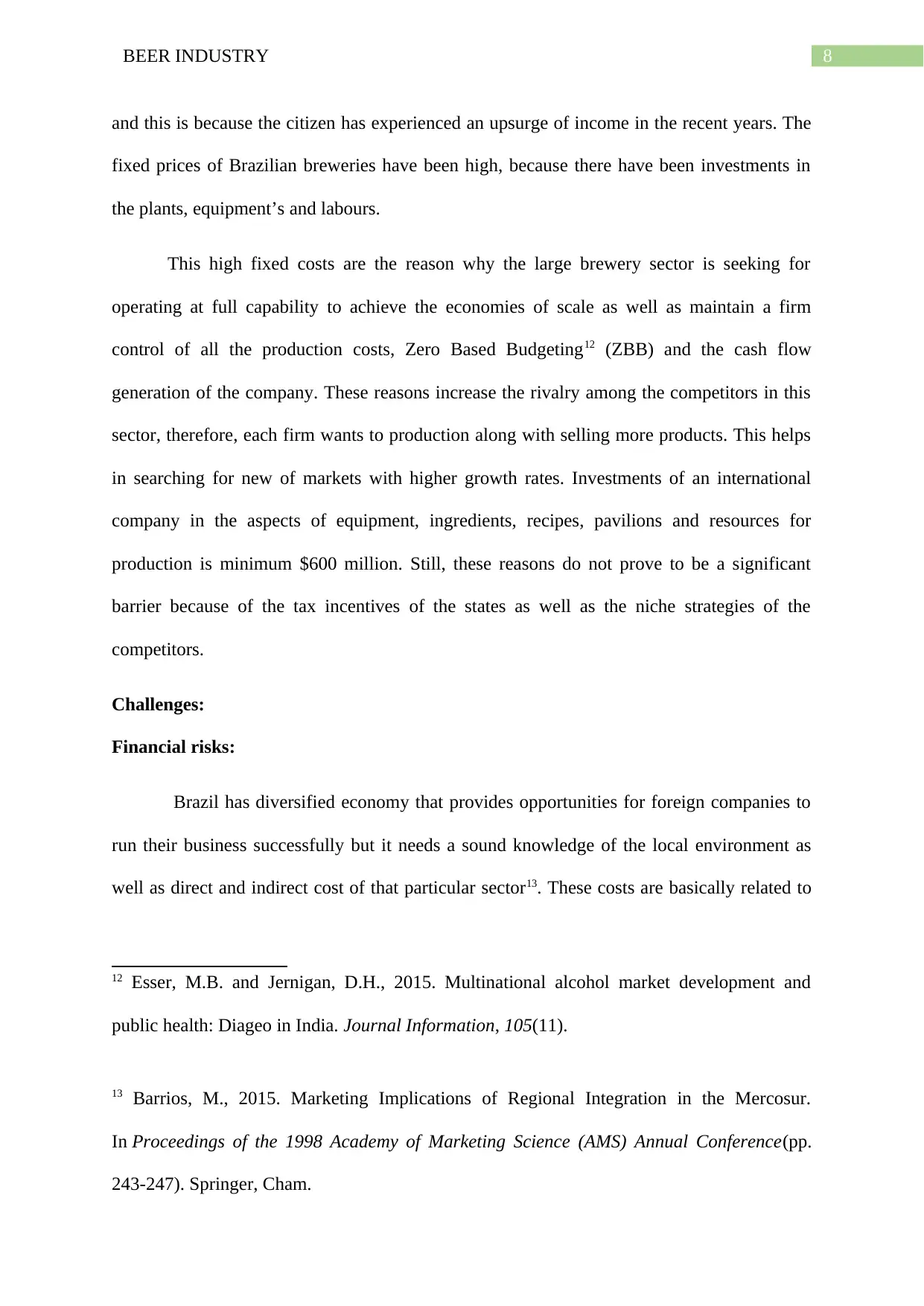
8BEER INDUSTRY
and this is because the citizen has experienced an upsurge of income in the recent years. The
fixed prices of Brazilian breweries have been high, because there have been investments in
the plants, equipment’s and labours.
This high fixed costs are the reason why the large brewery sector is seeking for
operating at full capability to achieve the economies of scale as well as maintain a firm
control of all the production costs, Zero Based Budgeting12 (ZBB) and the cash flow
generation of the company. These reasons increase the rivalry among the competitors in this
sector, therefore, each firm wants to production along with selling more products. This helps
in searching for new of markets with higher growth rates. Investments of an international
company in the aspects of equipment, ingredients, recipes, pavilions and resources for
production is minimum $600 million. Still, these reasons do not prove to be a significant
barrier because of the tax incentives of the states as well as the niche strategies of the
competitors.
Challenges:
Financial risks:
Brazil has diversified economy that provides opportunities for foreign companies to
run their business successfully but it needs a sound knowledge of the local environment as
well as direct and indirect cost of that particular sector13. These costs are basically related to
12 Esser, M.B. and Jernigan, D.H., 2015. Multinational alcohol market development and
public health: Diageo in India. Journal Information, 105(11).
13 Barrios, M., 2015. Marketing Implications of Regional Integration in the Mercosur.
In Proceedings of the 1998 Academy of Marketing Science (AMS) Annual Conference(pp.
243-247). Springer, Cham.
and this is because the citizen has experienced an upsurge of income in the recent years. The
fixed prices of Brazilian breweries have been high, because there have been investments in
the plants, equipment’s and labours.
This high fixed costs are the reason why the large brewery sector is seeking for
operating at full capability to achieve the economies of scale as well as maintain a firm
control of all the production costs, Zero Based Budgeting12 (ZBB) and the cash flow
generation of the company. These reasons increase the rivalry among the competitors in this
sector, therefore, each firm wants to production along with selling more products. This helps
in searching for new of markets with higher growth rates. Investments of an international
company in the aspects of equipment, ingredients, recipes, pavilions and resources for
production is minimum $600 million. Still, these reasons do not prove to be a significant
barrier because of the tax incentives of the states as well as the niche strategies of the
competitors.
Challenges:
Financial risks:
Brazil has diversified economy that provides opportunities for foreign companies to
run their business successfully but it needs a sound knowledge of the local environment as
well as direct and indirect cost of that particular sector13. These costs are basically related to
12 Esser, M.B. and Jernigan, D.H., 2015. Multinational alcohol market development and
public health: Diageo in India. Journal Information, 105(11).
13 Barrios, M., 2015. Marketing Implications of Regional Integration in the Mercosur.
In Proceedings of the 1998 Academy of Marketing Science (AMS) Annual Conference(pp.
243-247). Springer, Cham.
⊘ This is a preview!⊘
Do you want full access?
Subscribe today to unlock all pages.

Trusted by 1+ million students worldwide
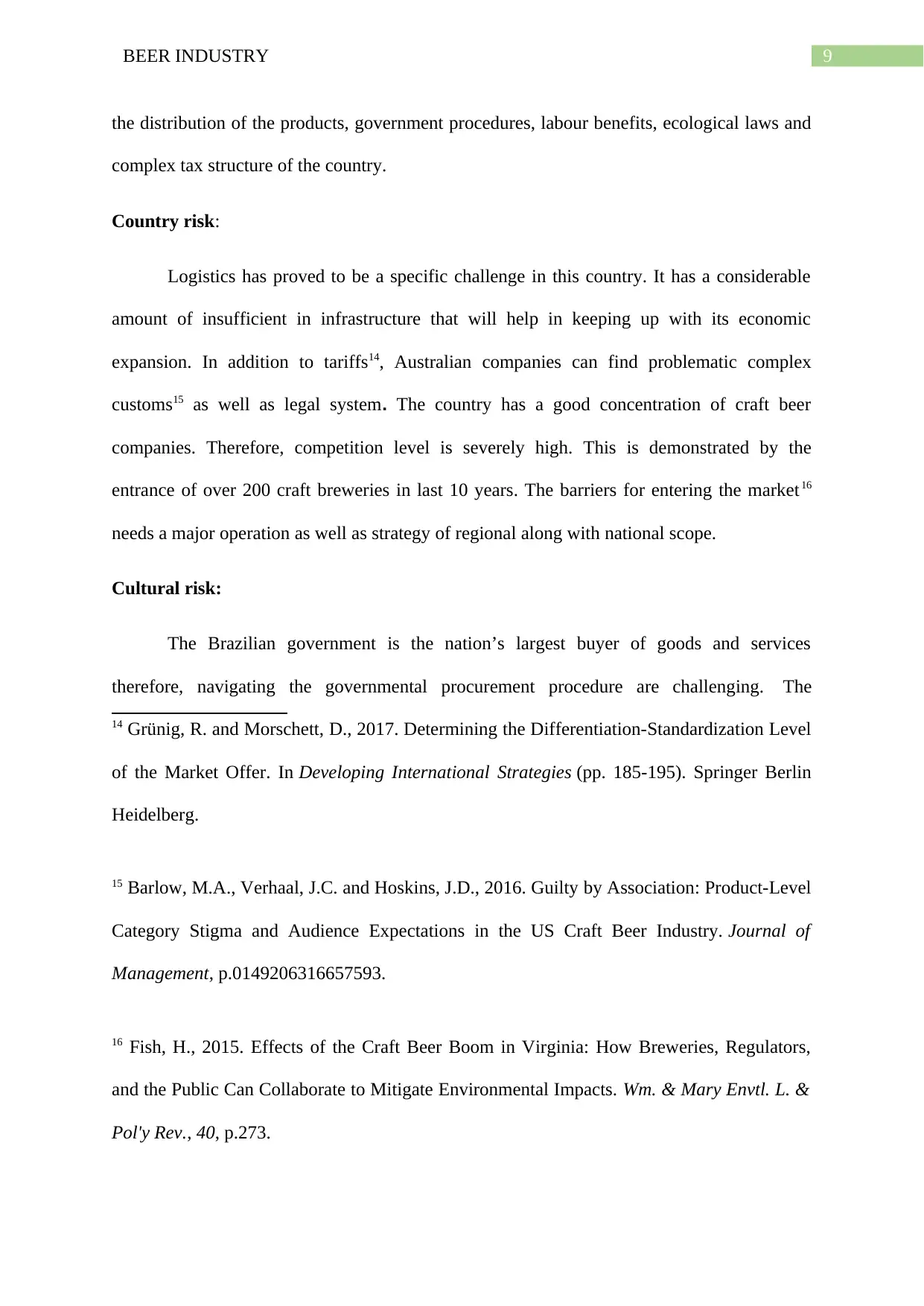
9BEER INDUSTRY
the distribution of the products, government procedures, labour benefits, ecological laws and
complex tax structure of the country.
Country risk:
Logistics has proved to be a specific challenge in this country. It has a considerable
amount of insufficient in infrastructure that will help in keeping up with its economic
expansion. In addition to tariffs14, Australian companies can find problematic complex
customs15 as well as legal system. The country has a good concentration of craft beer
companies. Therefore, competition level is severely high. This is demonstrated by the
entrance of over 200 craft breweries in last 10 years. The barriers for entering the market16
needs a major operation as well as strategy of regional along with national scope.
Cultural risk:
The Brazilian government is the nation’s largest buyer of goods and services
therefore, navigating the governmental procurement procedure are challenging. The
14 Grünig, R. and Morschett, D., 2017. Determining the Differentiation-Standardization Level
of the Market Offer. In Developing International Strategies (pp. 185-195). Springer Berlin
Heidelberg.
15 Barlow, M.A., Verhaal, J.C. and Hoskins, J.D., 2016. Guilty by Association: Product-Level
Category Stigma and Audience Expectations in the US Craft Beer Industry. Journal of
Management, p.0149206316657593.
16 Fish, H., 2015. Effects of the Craft Beer Boom in Virginia: How Breweries, Regulators,
and the Public Can Collaborate to Mitigate Environmental Impacts. Wm. & Mary Envtl. L. &
Pol'y Rev., 40, p.273.
the distribution of the products, government procedures, labour benefits, ecological laws and
complex tax structure of the country.
Country risk:
Logistics has proved to be a specific challenge in this country. It has a considerable
amount of insufficient in infrastructure that will help in keeping up with its economic
expansion. In addition to tariffs14, Australian companies can find problematic complex
customs15 as well as legal system. The country has a good concentration of craft beer
companies. Therefore, competition level is severely high. This is demonstrated by the
entrance of over 200 craft breweries in last 10 years. The barriers for entering the market16
needs a major operation as well as strategy of regional along with national scope.
Cultural risk:
The Brazilian government is the nation’s largest buyer of goods and services
therefore, navigating the governmental procurement procedure are challenging. The
14 Grünig, R. and Morschett, D., 2017. Determining the Differentiation-Standardization Level
of the Market Offer. In Developing International Strategies (pp. 185-195). Springer Berlin
Heidelberg.
15 Barlow, M.A., Verhaal, J.C. and Hoskins, J.D., 2016. Guilty by Association: Product-Level
Category Stigma and Audience Expectations in the US Craft Beer Industry. Journal of
Management, p.0149206316657593.
16 Fish, H., 2015. Effects of the Craft Beer Boom in Virginia: How Breweries, Regulators,
and the Public Can Collaborate to Mitigate Environmental Impacts. Wm. & Mary Envtl. L. &
Pol'y Rev., 40, p.273.
Paraphrase This Document
Need a fresh take? Get an instant paraphrase of this document with our AI Paraphraser
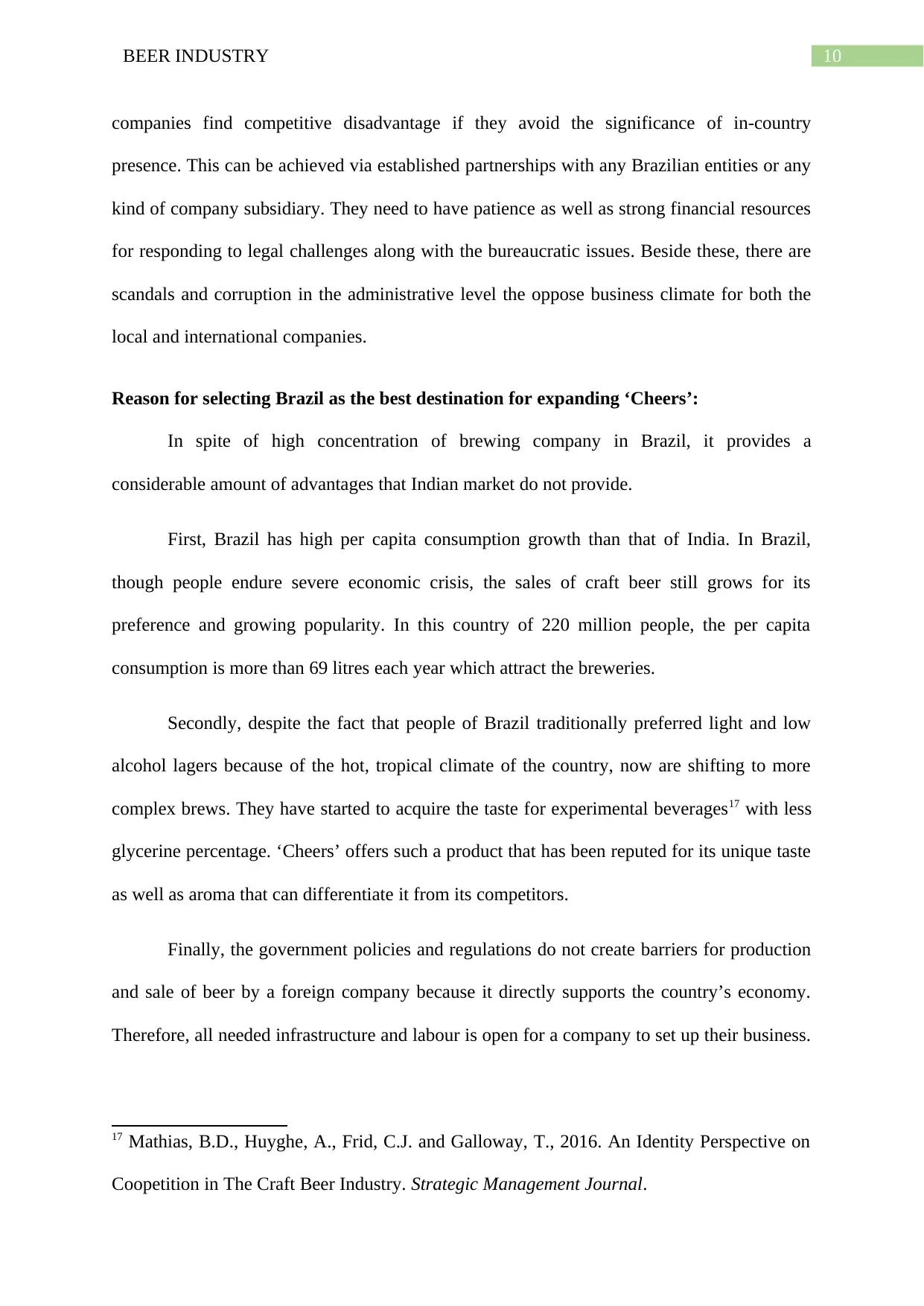
10BEER INDUSTRY
companies find competitive disadvantage if they avoid the significance of in-country
presence. This can be achieved via established partnerships with any Brazilian entities or any
kind of company subsidiary. They need to have patience as well as strong financial resources
for responding to legal challenges along with the bureaucratic issues. Beside these, there are
scandals and corruption in the administrative level the oppose business climate for both the
local and international companies.
Reason for selecting Brazil as the best destination for expanding ‘Cheers’:
In spite of high concentration of brewing company in Brazil, it provides a
considerable amount of advantages that Indian market do not provide.
First, Brazil has high per capita consumption growth than that of India. In Brazil,
though people endure severe economic crisis, the sales of craft beer still grows for its
preference and growing popularity. In this country of 220 million people, the per capita
consumption is more than 69 litres each year which attract the breweries.
Secondly, despite the fact that people of Brazil traditionally preferred light and low
alcohol lagers because of the hot, tropical climate of the country, now are shifting to more
complex brews. They have started to acquire the taste for experimental beverages17 with less
glycerine percentage. ‘Cheers’ offers such a product that has been reputed for its unique taste
as well as aroma that can differentiate it from its competitors.
Finally, the government policies and regulations do not create barriers for production
and sale of beer by a foreign company because it directly supports the country’s economy.
Therefore, all needed infrastructure and labour is open for a company to set up their business.
17 Mathias, B.D., Huyghe, A., Frid, C.J. and Galloway, T., 2016. An Identity Perspective on
Coopetition in The Craft Beer Industry. Strategic Management Journal.
companies find competitive disadvantage if they avoid the significance of in-country
presence. This can be achieved via established partnerships with any Brazilian entities or any
kind of company subsidiary. They need to have patience as well as strong financial resources
for responding to legal challenges along with the bureaucratic issues. Beside these, there are
scandals and corruption in the administrative level the oppose business climate for both the
local and international companies.
Reason for selecting Brazil as the best destination for expanding ‘Cheers’:
In spite of high concentration of brewing company in Brazil, it provides a
considerable amount of advantages that Indian market do not provide.
First, Brazil has high per capita consumption growth than that of India. In Brazil,
though people endure severe economic crisis, the sales of craft beer still grows for its
preference and growing popularity. In this country of 220 million people, the per capita
consumption is more than 69 litres each year which attract the breweries.
Secondly, despite the fact that people of Brazil traditionally preferred light and low
alcohol lagers because of the hot, tropical climate of the country, now are shifting to more
complex brews. They have started to acquire the taste for experimental beverages17 with less
glycerine percentage. ‘Cheers’ offers such a product that has been reputed for its unique taste
as well as aroma that can differentiate it from its competitors.
Finally, the government policies and regulations do not create barriers for production
and sale of beer by a foreign company because it directly supports the country’s economy.
Therefore, all needed infrastructure and labour is open for a company to set up their business.
17 Mathias, B.D., Huyghe, A., Frid, C.J. and Galloway, T., 2016. An Identity Perspective on
Coopetition in The Craft Beer Industry. Strategic Management Journal.
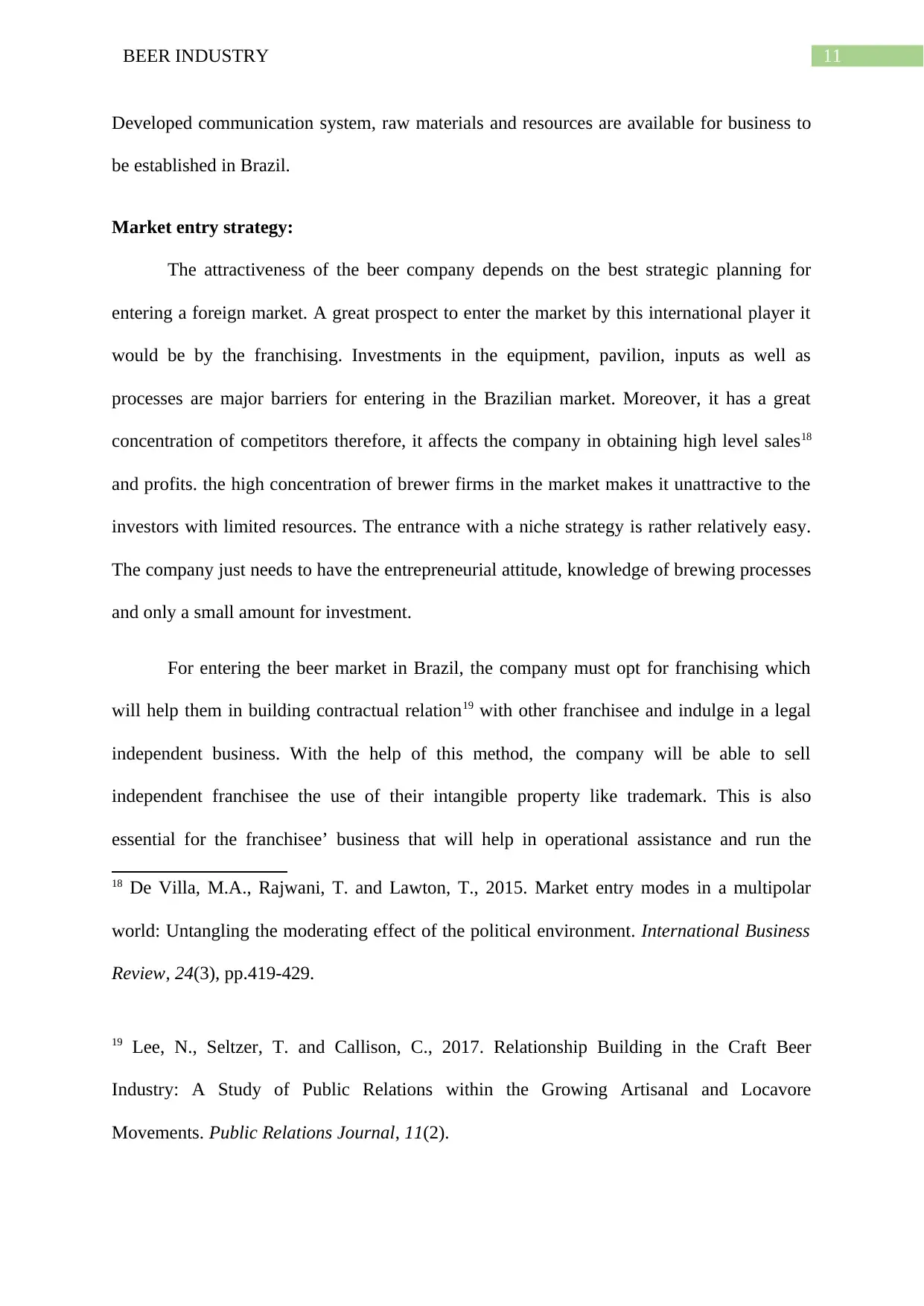
11BEER INDUSTRY
Developed communication system, raw materials and resources are available for business to
be established in Brazil.
Market entry strategy:
The attractiveness of the beer company depends on the best strategic planning for
entering a foreign market. A great prospect to enter the market by this international player it
would be by the franchising. Investments in the equipment, pavilion, inputs as well as
processes are major barriers for entering in the Brazilian market. Moreover, it has a great
concentration of competitors therefore, it affects the company in obtaining high level sales18
and profits. the high concentration of brewer firms in the market makes it unattractive to the
investors with limited resources. The entrance with a niche strategy is rather relatively easy.
The company just needs to have the entrepreneurial attitude, knowledge of brewing processes
and only a small amount for investment.
For entering the beer market in Brazil, the company must opt for franchising which
will help them in building contractual relation19 with other franchisee and indulge in a legal
independent business. With the help of this method, the company will be able to sell
independent franchisee the use of their intangible property like trademark. This is also
essential for the franchisee’ business that will help in operational assistance and run the
18 De Villa, M.A., Rajwani, T. and Lawton, T., 2015. Market entry modes in a multipolar
world: Untangling the moderating effect of the political environment. International Business
Review, 24(3), pp.419-429.
19 Lee, N., Seltzer, T. and Callison, C., 2017. Relationship Building in the Craft Beer
Industry: A Study of Public Relations within the Growing Artisanal and Locavore
Movements. Public Relations Journal, 11(2).
Developed communication system, raw materials and resources are available for business to
be established in Brazil.
Market entry strategy:
The attractiveness of the beer company depends on the best strategic planning for
entering a foreign market. A great prospect to enter the market by this international player it
would be by the franchising. Investments in the equipment, pavilion, inputs as well as
processes are major barriers for entering in the Brazilian market. Moreover, it has a great
concentration of competitors therefore, it affects the company in obtaining high level sales18
and profits. the high concentration of brewer firms in the market makes it unattractive to the
investors with limited resources. The entrance with a niche strategy is rather relatively easy.
The company just needs to have the entrepreneurial attitude, knowledge of brewing processes
and only a small amount for investment.
For entering the beer market in Brazil, the company must opt for franchising which
will help them in building contractual relation19 with other franchisee and indulge in a legal
independent business. With the help of this method, the company will be able to sell
independent franchisee the use of their intangible property like trademark. This is also
essential for the franchisee’ business that will help in operational assistance and run the
18 De Villa, M.A., Rajwani, T. and Lawton, T., 2015. Market entry modes in a multipolar
world: Untangling the moderating effect of the political environment. International Business
Review, 24(3), pp.419-429.
19 Lee, N., Seltzer, T. and Callison, C., 2017. Relationship Building in the Craft Beer
Industry: A Study of Public Relations within the Growing Artisanal and Locavore
Movements. Public Relations Journal, 11(2).
⊘ This is a preview!⊘
Do you want full access?
Subscribe today to unlock all pages.

Trusted by 1+ million students worldwide
1 out of 19
Related Documents
Your All-in-One AI-Powered Toolkit for Academic Success.
+13062052269
info@desklib.com
Available 24*7 on WhatsApp / Email
![[object Object]](/_next/static/media/star-bottom.7253800d.svg)
Unlock your academic potential
Copyright © 2020–2025 A2Z Services. All Rights Reserved. Developed and managed by ZUCOL.





